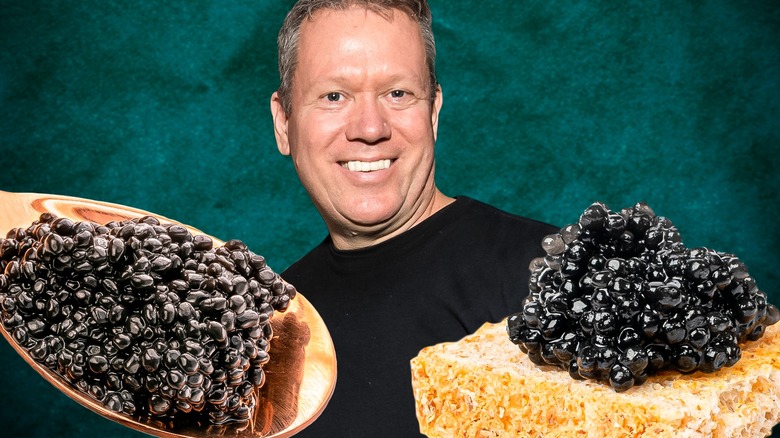Simple Tips For Pairing Caviar, According To Chef Walter Manzke
Perhaps no other ingredient is more associated with luxury and fine dining than caviar. What differentiates caviar from roe — and makes it that much more expensive — is the fish it comes from, which is an endangered farmed sturgeon. However, despite the almost universal high acclaim that caviar gets, there are a lot of ways to mess it up, mainly in the way it's served. After all, there are a lot of potential pairings that can interfere both with the unique feel of the caviar in your mouth, as well as the ocean-like, slightly salty, and fishy taste of this premium ingredient.
So if you're serving caviar to guests, or ordering at a restaurant, what should you pair with it to highlight its rich natural flavor and enhance it instead of overpowering it? In order to find out, we spoke with Chef Walter Manzke, the star head chef of famed LA restaurants like Bicyclette and Republique, to get his expert opinion.
Caviar is great alone
The first thing to emphasize is that caviar is such a high-quality ingredient, that it can be enjoyed without a single topping. As Manzke says, "I don't actually agree, and it's only my opinion too, on a lot of the traditional things that are with caviar, the hard-boiled eggs, and shallots, and crème fraiche... it overpowers it."
Premium caviar has a strong, briny flavor, and pairing it with other strong flavors will only interfere with the pure taste of the ingredient. This is especially true because caviar is one of those rare items for which the flavor continues to change and develop as you chew it, from the first taste onwards. You will experience a range of umami flavors, and powerful, contradictory flavors will mess with the way the flavor changes in your mouth. So if you're doubting your prospective caviar pairings, play it safe and eat it with nothing. Chef Manzke would agree with your decision, as he told us, "In fact, one of the really best ways to eat caviar is as it is, straight."
Soft bread and butter
However, if you do want to pair your expensive caviar with another ingredient, but don't want to resort to the standard cracker accompaniment, keep it simple with some soft bread and butter. Manzke prefers Rodolphe Le Meunier butter, which he uses extensively in all his restaurants.
"Great butter, like that Rodolphe Le Meunier butter that we use, is beautiful with caviar. And, generally, you wouldn't eat straight butter, so a little bit of bread kind of cuts it," says the world-class chef. Butter and caviar alone would be perhaps too indulgent and decadent of a combination, so the bread helps provide both a complementary texture as well as something to soak up all the delicious flavors you're serving. The premium butter Manzke mentioned comes from France and has a rich and creamy taste that perfectly complements the umami flavor of the caviar. When you're picking a bread to slice up and serve, pick a freshly baked baguette if possible to get a nice, soft texture.
Texture is key
The reason Chef Manzke also insists on soft bread is because chewy, textured, or otherwise crunchy breads interfere with the unique feel of the caviar, which is an integral part of the caviar dining experience. "A big part of [the caviar] is the texture of it in your mouth, and if you add something hard to it, it interferes with the texture, you don't want anything that gets in the way of the luxurious mouthfeel," Manzke explains.
So while crunchy breads or doughy slices may pair well with other ingredients, keep it soft and simple for caviar. That means that even a type of bread that is generally soft, like brioche bread, should be served with caviar close to the time it was baked. Otherwise, if you wait a few days, even the softest of bread will have become stale and somewhat hard, not to mention have lost that beautiful straight-from-the-bakery flavor.



